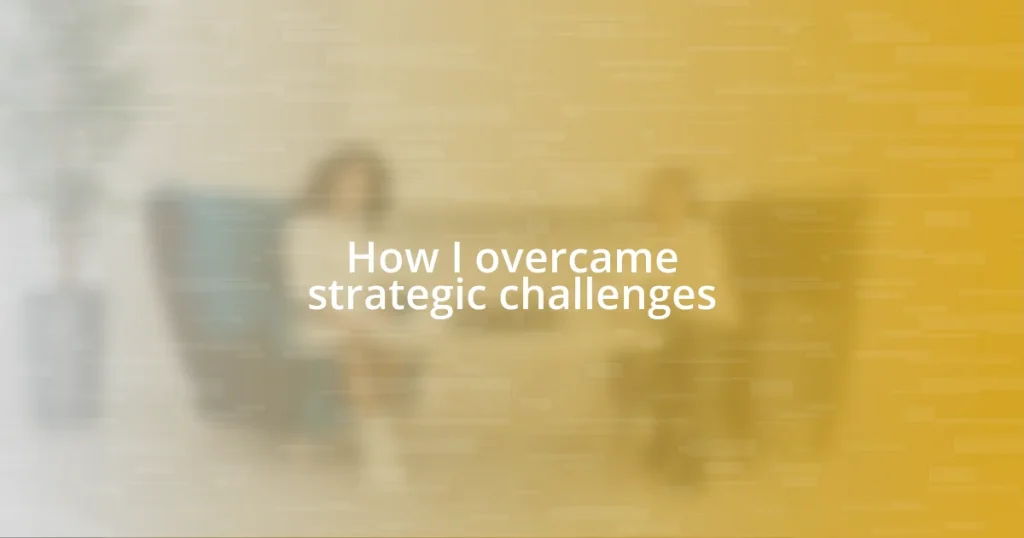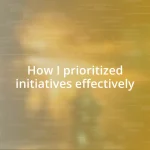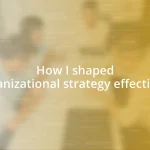Key takeaways:
- Identifying personal challenges, such as fear of vulnerability and inefficiency, can significantly impact team performance and lead to meaningful change.
- Implementing a strategic action plan with clear objectives, task prioritization, and flexibility fosters team ownership and proactivity in overcoming challenges.
- Regular reflection and celebration of successes build morale, reinforce team connections, and provide valuable insights for continuous improvement.

Identifying My Strategic Challenges
Identifying my strategic challenges often felt like a daunting task, much like trying to solve a jigsaw puzzle with missing pieces. I remember a time when I was working on a project that was falling behind schedule, and I had to take a hard look at what was really causing this hiccup. Was it the lack of resources, inadequate planning, or perhaps my own hesitation to delegate tasks?
At one point, I realized that my biggest challenge was my own mindset. I clung to the idea that I had to handle everything myself, which bred stress and inefficiency. This revelation hit me hard—how often do we hold ourselves back with self-imposed barriers?
Through honest self-reflection, I discovered that my strategic challenges were deeply tied to my fear of vulnerability. I was scared of showing weakness, which ironically made it harder to leverage the strengths of my team. How can we truly move forward if we don’t first understand the roots of our struggles?

Analyzing the Root Causes
Analyzing the root causes of my strategic challenges was an eye-opening experience. I vividly recall a team meeting where frustration boiled over due to miscommunication. It dawned on me that the absence of clear roles and responsibilities was a significant contributor to our delays. By digging deeper, I recognized that this confusion stemmed from my assumption that everyone was on the same page, a classic case of overconfidence leading to underperformance.
Understanding the specific factors behind my challenges involved some tough conversations and self-examination. I realized that beyond just logistical issues, emotional elements were at play. For instance:
- Fear of failure: I often hesitated to take risks, worrying about potential mistakes.
- Lack of transparency: I didn’t communicate effectively, which led to misunderstandings within my team.
- Inconsistent priorities: My shifting focus meant that my team struggled to align their efforts with the overarching goals.
Coming to terms with these root causes laid the groundwork for meaningful change. It felt good to confront these issues head-on, allowing both me and my team to learn and grow from the experience.

Developing a Strategic Action Plan
Developing a strategic action plan requires a blend of clarity and commitment. I recall a pivotal moment when I decided to formalize my approach. It wasn’t just about writing down steps; it was a deeply reflective process. I gathered my team and laid out our objectives, ensuring we all shared a common vision. This collaborative spirit ignited a genuine excitement, and I watched as each member began to take ownership of their roles.
One of the most effective strategies I used was to prioritize tasks based on their impact and urgency. I remember a time when I felt overwhelmed by the number of projects on my plate. By implementing a simple matrix to categorize tasks, I was able to turn chaos into clarity. This process not only alleviated my anxiety but also helped my team focus on what truly mattered. Suddenly, we weren’t just reacting to situations; we were proactively steering our efforts in the right direction.
I also found that flexibility was key in our action plan. Life throws curveballs, and it’s essential to adapt when circumstances change. I experienced this firsthand when a major project pivot required us to shift gears rapidly. Instead of sticking rigidly to our original plan, we convened to brainstorm new approaches. This openness fostered creativity and innovation. I learned that a strategic plan thrives when it’s alive and responsive, not just a static document gathering dust.
| Action Plan Element | Details |
|---|---|
| Objective Setting | Collaborative process with team input |
| Task Prioritization | Matrix for impact and urgency analysis |
| Flexibility | Adaptation based on changing circumstances |

Implementing Effective Solutions
Implementing effective solutions often feels like unraveling a complex puzzle, and I genuinely enjoy the process. One vivid example was when I decided to introduce regular feedback loops within my team. Initially, I was nervous about how my colleagues would respond. I remember thinking, “What if they don’t feel comfortable sharing their true thoughts?” But as we began to foster an open dialogue, I was pleasantly surprised. The trust we built not only improved our communication but also led to innovative solutions that I had never anticipated.
Creating solutions isn’t just about finding the right answers—it’s also about cultivating the right environment. I still recall how pivotal a brainstorming session became for us. It started with a simple question, “What if we turned our setbacks into stepping stones?” That one question encouraged my team to brainstorm creative approaches instead of lingering on past mistakes, shifting our focus towards new possibilities. The room was electric with ideas, and I felt a wave of optimism wash over me. It reinforced my belief that when people feel empowered, they can overcome significant hurdles together.
Another important aspect was tracking our progress through visual tools. Early on, I found it challenging to gauge how far we had come. It was during a project update meeting that a colorful chart I created sparked excitement among my team. “Look at how much we’ve achieved!” one member exclaimed, pointing to the upward trajectory. It was a moment of realization for me: the visibility of our success not only motivated us but also reinforced a collective sense of accountability. I learned that celebrating small wins along the way can have a ripple effect on team morale and engagement.

Tracking Progress and Outcomes
Tracking progress and outcomes is crucial for maintaining focus and accountability throughout any strategic initiative. I remember implementing a simple yet effective tool—a progress tracker spreadsheet. Each week, we would update our achievements, and there was something incredibly satisfying about watching the numbers grow. It wasn’t just data; it felt like we were charting our collective journey, and that visualization kept the momentum alive for the entire team.
During one particularly challenging project, I noticed that morale began to dip. It prompted me to host a small celebration for every milestone, no matter how small. I vividly recall our first little party at the office when we completed the initial stages of a daunting task. The cheers and laughter that filled the room recharged our spirits. It made me realize that acknowledging progress doesn’t just mark the road we’ve traveled; it inspires us to keep pushing forward.
Additionally, I learned the power of feedback in tracking outcomes. After every completed phase, I initiated debrief sessions to discuss what worked and what didn’t. I’ll never forget the heartfelt insights shared during one of those sessions—team members revealed how much they valued the opportunity to voice their thoughts. This practice didn’t just help us clarify our next steps; it fostered a sense of ownership, making each member feel integral to our journey. How often do we check in on our progress in a meaningful way? In my experience, those conversations are the heartbeat of ongoing success.

Adapting Strategies for Future Challenges
Adapting strategies for future challenges requires a mindset shift. I once faced a situation where an unexpected market change forced us to pivot quickly. I remember sitting at my desk, feeling overwhelmed, but then I thought, “What if this is an opportunity instead of a setback?” This simple question opened a door for creative brainstorming, leading to a successful campaign that revitalized our approach and brought in new clients.
In another instance, when we encountered resource constraints, I realized our team had to become more resourceful. Instead of solely relying on external tools, we began to leverage our collective skills and talents. I organized skills-sharing sessions, where team members could teach one another. It was incredible to witness how sharing knowledge not only diversified our capabilities but also deepened our connections. Have you ever noticed how collaboration breeds innovation? I certainly felt it firsthand as we crafted solutions that I never could have envisioned alone.
Looking ahead, I’ve come to understand that continuous learning is fundamental in adapting strategies. I actively seek feedback—not just from my team, but also from mentors and industry peers. This creates a rich tapestry of insights that can light the way through uncertain times. I remember a conversation with a mentor who advised me, “Embrace the discomfort of change.” That advice resonates with me even now; it reminds me that every challenge carries the seed of opportunity, and our ability to adapt depends on our willingness to embrace those moments when discomfort arises.

Celebrating Success and Reflecting
Celebrating success is more than a simple acknowledgement; it’s a way to create lasting memories. I recall a time when we completed a significant project, and instead of moving on to the next task immediately, I suggested we take a moment to reflect. Over a casual lunch, we shared our proudest moments from the project. Hearing my colleagues recount their triumphs reminded me just how far we’d come together. It made me realize that savoring these peak moments of achievement deepens our connections and fuels our collective drive.
When milestones are met, I find it essential to pause and embrace the joy of the moment, which sometimes gets overlooked in the hustle of day-to-day work. For instance, after we successfully navigated a tough quarter, I organized a small awards ceremony. I felt such warmth as each team member received recognition for their contributions. Such celebrations not only boost morale but also reinforce a culture of appreciation—it was wonderful to see smiles lighting up their faces. Have you ever experienced that rush of gratitude when your efforts are publicly acknowledged? It’s truly uplifting.
Reflecting on what we’ve accomplished doesn’t just bring closure; it illuminates the path ahead. After our celebrations, I’d often lead a session where we discussed lessons learned. One particular discussion about overcoming setbacks left a lasting impression on me; a team member shared how taking risks had opened new doors for her. I couldn’t help but think about how powerful our stories can be. In those moments, I appreciate that success isn’t just about what we achieve, but also about how we grow together through each experience.















